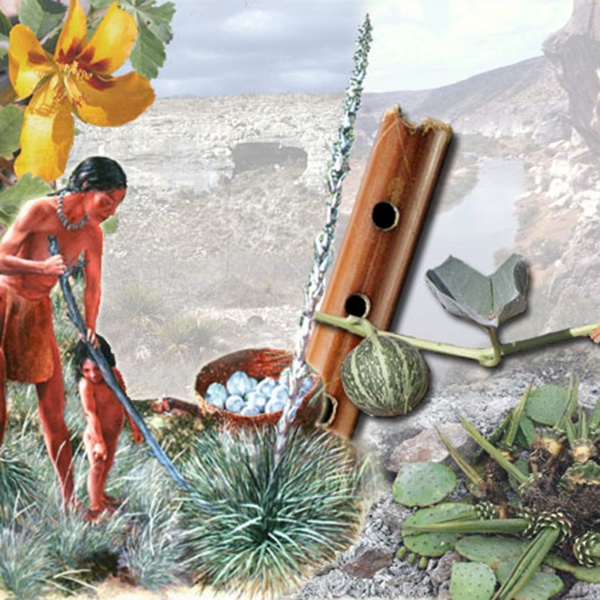Plants in Texas

Download lesson plan and included materials
Subject: Science and Social Studies
Grade: 7th
Author: Audra Roach, revised by Mary Rodriguez and Jason Terry (2023)
Time Duration: One or two 45-minute class periods
Overview: Students will compare and contrast the ways in which early people used plants in Texas millennia ago with the ways that Texans uses plants today.
Objective: Compare and contrast continuity and change over time; identify various plant materials, past and present; compare how people in different communities adapt to the physical environment, past and present; write to record, develop, and reflect on ideas.
TEKS: Science, Grade 7
- (1A), ask questions and define problems based on observations or information from text, phenomena, models, or investigations
- (1E), collect quantitative data using the International System of Units (SI) and qualitative data as evidence
- (3B), communicate explanations and solutions individually and collaboratively in a variety of settings and formats
Social Studies, Grade 7
- (2A), compare the cultures of American Indians in Texas prior to European colonization such as Gulf, Plains, Puebloan, and Southeastern
- (9A), identify ways in which Texans have adapted to and modified the environment and explain the positive and negative consequences of the modifications
- (22C), create written, oral, and visual presentations of social studies information
Materials:
- Computers with Internet access for www.texasbeyondhistory.net/pecos
- Plants in Texas: Then and Now Activity Page (included)
- Background for teacher (included)
Activities and Procedures:
Step 1: Introduce students to the different ways in which ancient Texan’s used plants by viewing Texas Beyond History’s Lower Pecos Canyonlands exhibit (www.texasbeyondhistory.net/pecos). View displays of artifacts preserved in the dry caves and rock shelters of far west Texas, including a cane flute, a prickly pear pouch, a sewing needle, cords, nets, sandals, and baskets made from plant fibers. Also see the artifacts from Ceremonial Cave near El Paso, including an “apron” made of woven plant fiber cording, a fire hearth made yucca stalk, and spear shafts made of cane and wrapped with plant fibers. View an ancient “backpack” called a kiaha made from plant fibers at Granado Cave.
Step 2: Students list different objects made from plants thousands of years ago on the activity page, and the purpose for each object. Modification: Fill in artifacts column for students on the activity page.
Step 3: For homework, students go on a “scavenger hunt” of their own homes and record the modern plant-based materials they find on the Activity Page.
Step 3: For homework, students go on a “scavenger hunt” of their own homes and record the modern plant-based materials they find on the Activity Page.
Step 4: Invite students to share their findings in pairs. Then, with the whole class, create a Venn diagram on chart paper that compares and contrasts early and modern people’s uses of plants. Put common purposes/objects in the center of the diagram. Discuss what is different and what has remained the same.
Closure: Ask students to separate a blank sheet of writing paper into two columns. In separate columns, respond to the following situations:
- Column 1: Imagine you are a hunter-gatherer in Texas 11,000 years ago. You are taking a journey and need a new pair of sandals. How will you get them? Where will they come from? How will they be made?
- Column 2: Now imagine that you are a modern person in Texas in the year 2024. You are going camping and need a new pair of sandals. How will you get them? Where will they come from? How will they be made?
Extension Activities:
- Challenge students to expand their “scavenger hunt” to their schoolyard or neighborhoods. Wildflowers, leaves, and acorns might be sketched into science journals and identified using field guides and internet resources. Fallen leaves might be pressed and saved into a class-published field guide to local vegetation.
- Practice weaving necklaces or baskets out of yarn or raffia. For examples of prehistoric weaving, see the Granado Cave exhibit at: www.texasbeyondhistory.net/granado/artifacts.html
Student Product: Completed Plants in Texas: Then & Now Activity Page